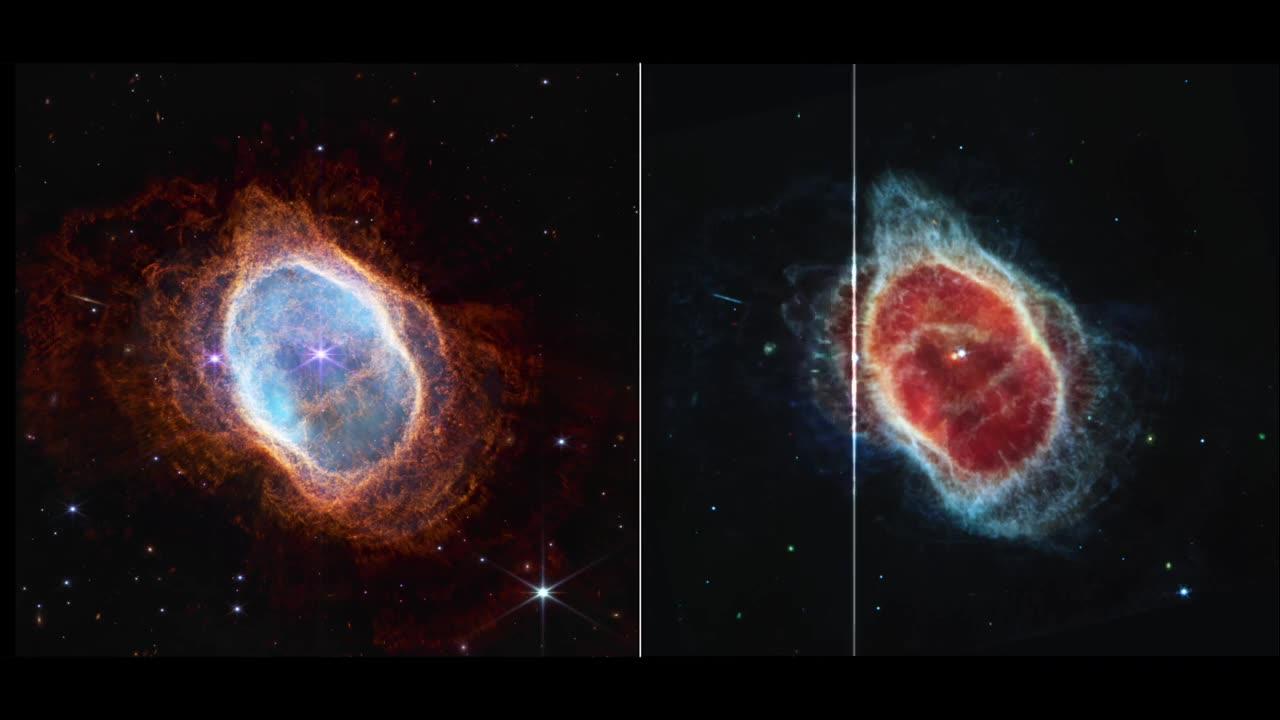
Experience the first full-color images and data from NASA’s James Webb Space Telescope in a brand new way.
In this video, each of Webb's two views of the Southern Ring Nebula — in near-infrared light (at left) and mid-infrared light (at right) — has been adapted to sound.
Sonifications support blind and low-vision listeners first, but are designed to be captivating to anyone who tunes in.
This sonification, which scans the images from left to right, was adapted to a video to allow sighted viewers to watch as a vertical line moves across the frame.
Two stars orbit one another at the center of this planetary nebula.
The smaller, fainter red star in the mid-infrared image at right is at the end of its lifetime.
It has puffed off layers of gas and dust for thousands of years.
Its companion, the brighter, larger star in both images, has stirred up those ejections.
Now, listeners can hear the stars and surrounding shells of material in each image clearly.
The colors in the images were mapped to pitches of sound, with frequencies of light converted directly to frequencies of sound.
Near-infrared light is represented by a higher range of frequencies at the beginning of the track.
Mid-way through, the notes change, becoming lower overall to reflect that mid-infrared includes longer wavelengths of light.
Listen carefully at 15 seconds and 44 seconds.
These notes align with the centers of the near- and mid-infrared images, where the stars at the center of the “action” appear.
In the near-infrared image that begins the track, only one star is heard clearly, with a louder clang.
In the second half of the track, listeners will hear a low note just before a higher note, which denotes that two stars were detected in mid-infrared light.
The lower note represents the redder star that created this nebula, and the second is the star that appears brighter and larger.
This sonification does not represent sounds recorded in space.
Two musicians mapped the telescope’s data to sound, carefully composing music that represents near- and mid-infrared light, specifically to hear their contrasts.
In a way, this sonification is like modern dance or an abstract painting – it converts two of Webb’s images into a new medium to engage and inspire listeners.
Learn more: https://www.nasa.gov/feature/goddard/2022/nasa-webb-s-first-full-color-images-data-are-set-to-sound Listen to Webb's near-infrared and mid-infrared images of the Southern Ring Nebula individually: 1.
Near-infrared: https://youtu.be/k7zNJsf3z7w 2.
Mid-infrared: https://youtu.be/ui0Rpvi1axs Want more Webb sonifications?
Check out the Carina Nebula sonification (https://youtu.be/j9shIxS-W-8), and the WASP-96 b sonification (https://youtu.be/vqa94WD6smc).
Credits: Image: NASA, ESA, CSA, and STScI; Accessibility Production: NASA, ESA, CSA, STScI, and Kimberly Arcand (CXC/SAO), Matt Russo and Andrew Santaguida (SYSTEM Sounds), Quyen Hart (STScI), Claire Blome (STScI), and Christine Malec (consultant).


